
Design, if it is to be ecologically responsible and socially
Design, if it is to be ecologically responsible and socially responsive, must be revolutionary and radical.






“Design, if it is to be ecologically responsible and socially responsive, must be revolutionary and radical.” – Victor Papanek
In these powerful words, Victor Papanek, the philosopher and prophet of sustainable design, declares a truth that strikes at the heart of civilization’s relationship with creation. He reminds us that design — that ancient act of shaping the world — is not neutral. It is either an instrument of healing or an agent of harm. To design responsibly, he says, is not to decorate the surface of life, but to transform its foundations. True design must be revolutionary and radical, for only through boldness can humanity repair what it has broken — the balance between man, society, and nature.
To understand this, we must first understand who Papanek was and why he spoke with such urgency. Born in the turbulence of the twentieth century, he witnessed the rise of industry, the spread of consumerism, and the slow poisoning of the earth beneath human ambition. He saw that design — once the noble craft of improving life — had become enslaved to profit and excess. Products were made not to serve, but to sell. Objects were crafted not for longevity, but for waste. In his landmark work, Design for the Real World (1971), Papanek raised his voice like an ancient sage crying out against the vanity of his age: “There are professions more harmful than industrial design,” he wrote, “but only a few.” It was not cynicism, but righteous anger — the cry of one who believed that design must return to its sacred purpose: to serve humanity and protect the planet.
When Papanek says design must be revolutionary, he means that it must defy the old order — the systems of greed that build without conscience and consume without end. To be revolutionary is to refuse complacency, to question the structures that define “normal.” It is to look upon the world and say: “This is not good enough.” The radical designer, then, is not one who makes things strange for the sake of novelty, but one who digs to the root — for the word “radical” itself comes from radix, meaning root. He digs beneath the surface to ask: What do people truly need? What does the planet truly sustain? His work is rebellion not for destruction’s sake, but for renewal.
Throughout history, the revolutionary spirit of design has always arisen when humanity has faced crisis. Consider the work of Buckminster Fuller, who, in the wake of war and resource scarcity, envisioned geodesic domes — structures that were light, efficient, and sustainable. Or Isamu Noguchi, who designed playgrounds where art and function merged, teaching that design could nourish the soul as much as the body. These were not designers chasing luxury; they were builders of balance, dreamers who saw beyond the conventions of their time. Like Papanek, they understood that to design well is to care deeply — to see design not as an indulgence of the few, but as a responsibility to the many.
To be ecologically responsible, a designer must hear the voice of the earth — the rivers, the soil, the air. Every line drawn, every product made, is an act that either restores or destroys. The wise designer creates as the ancient builders did, in reverence for nature’s order. To be socially responsive, one must listen also to the human heart — to the poor, the disabled, the marginalized, whose needs are often ignored by the marketplace. Papanek believed that design divorced from empathy is corruption — and that the designer who does not design for all, designs for none. Thus, the revolutionary designer is not one who builds monuments, but one who creates solutions: a stove that saves fuel, a home that cools without power, a tool that empowers a village. Such works may not gleam with glamour, but they shine with righteousness.
The lesson is clear: to be a designer — whether of buildings, systems, or ideas — is to bear the weight of stewardship. We must each ask: What am I shaping with my hands, my mind, my choices? Papanek calls us to awaken our conscience. To design anything — a product, a policy, a life — without regard for its impact is to betray our own future. To design with awareness, humility, and courage is to participate in the world’s renewal. And though such a path demands sacrifice, it also grants meaning — for nothing is more divine than to create in harmony with the living world.
So, my listener, remember this: comfort without conscience is decay, and progress without purpose is peril. The age of careless design is ending; the age of responsible creation must begin. Whether you craft music or machines, gardens or cities, design with reverence for life. Be radical in compassion, revolutionary in vision, and responsible in action. For only those who dare to design a better world will inherit one. And when they do, the earth itself will sigh in relief — and whisper, “At last, they have remembered what it means to create.”






AAdministratorAdministrator
Welcome, honored guests. Please leave a comment, we will respond soon